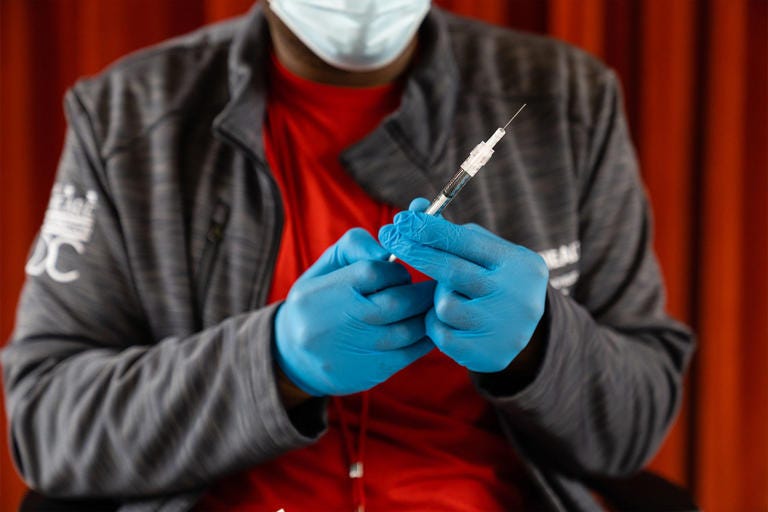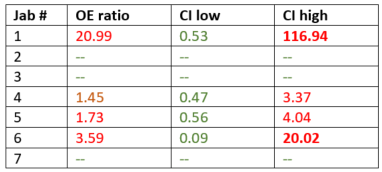"Major COVID Vaccine Study Finds Heart Risks Are Rare - Real Threat Is Not Being Vaccinated"
The findings of the study are grossly misconstrued. 304,520.00% increased risk of blood clotting in the brain reported. Is this a new definition of "exceptionally rare"?
Another day, another lie, this time mostly by the mainstream media. Notice how the following article only singles out “heart risks” in its headline and omits, for the reasons that will be made clear below, any&all other adverse “vaccine” administration consequences. “Major COVID vaccine study finds heart risks are rare — and the real threat is being unvaccinated” (Salon, 2024.02.23):
The study included 99 million people across eight countries and found that the first, second and third doses of Pfizer-BioNTech’s and Moderna’s mRNA vaccines were linked to rare cases of myocarditis. Specifically, people who received a second dose of Moderna vaccine were 6.1 times more likely to have myocarditis.
6.1 times more likely is rare? Also, they aggregated across all age cohorts, and we know that young males are many times more prone to this condition. For starters.
The condition also developed among people who received the Pfizer vaccine while researchers identified that pericarditis had a 6.9-fold increased risk for those who received a third dose of AstraZeneca’s vaccine.
6.9 times for 3rd AstraZeneca. “Extremely rare”!
There was also a 2.5-times increased risk of developing the rare autoimmune disorder called Guillain-Barré syndrome linked to those who received AstraZeneca’s vaccine.
2.5 times GBS: AstraZeneca comes up on top again? (see below - they are being too modest).
The rest of the article goes on explaining why these findings are safe to dismiss.
The Guardian is a bit more outgoing in the title of the article about the same study, “Two very rare Covid vaccine side-effects detected in global study of 99 million” (Guardian, 2024.02.22), yet more deceitful in the subtitle:
Results confirm how uncommon known complications are as researchers confirm benefits from vaccines still ‘vastly outweigh the risks’
The Guardian’s article goes on to say:
Two new (but exceptionally rare) Covid-19 vaccine side effects – a neurological disorder and inflammation of the spinal cord – have been detected by researchers in the largest vaccine safety study to date. A new rare side-effect, acute disseminated encephalomyelitis – an inflammation and swelling in the brain and spinal cord – was also identified in the data analysis as being linked to the AstraZeneca vaccine. Not only did the Australian study confirm acute disseminated encephalomyelitis as a rare side-effect, but the large amount of AstraZeneca-specific data also allowed them to detect a second new rare side-effect, known as transverse myelitis, or spinal cord inflammation.
Buttery, a senior research analyst with the Murdoch Children’s Research Institute in Australia, said “for rare side effects, we don’t learn about them until the vaccine has been used in millions of people”.
Or is it billions? In spite of this, the jabs can be safely spread on your breakfast toast:
The study of more than 99 million people from Australia, Argentina, Canada, Denmark, Finland, France, New Zealand and Scotland also confirmed how rare known vaccine complications are, with researchers confirming that the benefits of Covid-19 vaccines still “vastly outweigh the risks”.
At that last statement is a conjecture totally unrelated to the study at hand. Because the study did not concern itself with evaluating the risks to the unvaccinated of not getting the jabs. At all. And we know these data are not available because they were actively tainted and manipulated, especially with the freshly jabbed counted as unvaccinated until two weeks post second mRNA jab, and 2 weeks post the AZ and J&J.
And how did the study, “COVID-19 vaccines and adverse events of special interest: A multinational Global Vaccine Data Network (GVDN) cohort study of 99 million vaccinated individuals” (Vaccine, 2024.02.12), attribute the adverse events (AEs) to a jab administered? Glad you’ve asked! The supplement (a Word doc) stipulates that an AE may only happen in 0-42 post the jab administration! And whatever happens to the vaccinee in less than one a a half month later is totally his/her own fault and does not count against the jab. Like, if you died suddenly “in your sleep” six weeks plus a day. 42 days — the jab, 43 days — definitely not the jab! Makes sense? Unlike with the unvaccinated: whatever ever happens is always blamed on them not being Covid-vaccinated, for the rest of their lives. You get my point?
Now to the study. This next slide should blow your mind! Not only some jabs produced 20, 40, 50, and up to 67 times more cardiovascular AEs than expected:
About half of the time (circled in blue), the severity of the AE is not color-coded according to their own statistically significant thresholds (The OE ratio <=1.0 - green, >1 to <=1.5 - yellow, >1.5 times - red) on a technicality that the lower bound of the confidence interval, not the value itself, must be over the threshold. Otherwise the picture above would have been almost totally red.
It’s important at this point to understand what a confidence interval is. A confidence interval in these statistics is the range of inputs that captures, in this study, 95% of them:
More specifically, given a confidence level γ (95% and 99% are typical values), a CI is a random interval which contains the parameter being estimated γ% of the time.
So, if out of 8 medical authorities one of them reported a low incidence of the AE and the rest 7 reported sky-high incidences, the lower confidence interval bound will be defined by that one medical authority report and the study authors use it as an excuse to dismiss the result as statistically insignificant. For example, in the table above, Novavax produced 39.26 times observed versus expected ratio (OE) of myocarditis AEs after the second jab. But this result has been dismissed, as one medical authority reported the OE ratio of 0.99 while another reported the OE ratio of 218.74, for the confidence interval (CI) of 0.99-218.64. In total, the OE ratio was, again, 39.26 (!), but it has been dismissed as insignificant. The absolute champion is Novavax with 3,045.2-times (sic!) cerebral venous sinus thrombosis (SVST) AEs, on the high end (see the haematologic conditions table below). In my mind at least, it’s totally dishonest. But that’s how the science is made nowadays.
In the cerebral venous sinus thrombosis (SVST) AEs and splanchnic vein thrombosis (SVT) AEs, some jabs punched above their weight to achieve up to 108.71-546.67 (sic!), and 113 (sic!) times the risk accordingly, on average:
Here’s the picture for neurological conditions:
The modest Novavax punched out at 62.83 (CI 1.59-350.05), and Moderna at 12.31 times the risk (CI 1.49-44.46). And the 6th Biontech mRNA jab excelled in generalised seizures (GSZ) at 15.65 times!
Now, remember that “meager” AstraZeneca’s 2.49-times AEs of GBV after the 1st jab? It turns out that the 3rd AstraZeneca jab produced 3.99-times AEs of GBS (CI 0.48-14.41).
I leave the rest of the conditions to be perused by motivated readers in the mentioned already supplement, provided you have a viewer for Word documents.
What also strikes me in these tables is the abject inconsistency of the statistics of consecutive jab administrations (by the booster number): instead of seeing some sort of a progression (OE ratios either trending up or down), we see wild gyrations, like Novavax GBS OE ratio of 0 after 1st jab, up to 350.05 after 2nd, then nothing at all after that, Novavax seemingly not administered any more after that spectacular result in the 8 jurisdictions? A better example is with the OE ratio of myocarditis (MYO), the first table above, for Comirnaty or Riltozinameran or Pfizer/BioNTech COVID-19 Vaccine Bivalent [Pfizer/BioNTech] (BIBNT):
What is going on here? My unqualified guess would be that the medical authorities worked hard to suppress the reported AEs after seeing the results of the 1st jab, but then gradually relaxed after the 3rd jab, or got more pushback from the reporting doctors/patients? So, any numbers in the results above should be entertained with the possibility of an outright fraud in some reported AE numbers in mind.
But on balance, there are so many horrendously strong “signals” of Covid jab harmfulness in the published results, only in the first 42 days post jabs, that only a totally dishonest person can come up with the conclusion and a headline that “it would have been so much worse and there is nothing to worry about”. IMHO. Yet, I’d like to know how those sky-high (in hundreds and even thousands) OE ratios in the first 0-42 days post jab translate into the total severe AEs in those 99 million people covered by the study, up to date. I believe it may well be in hundreds of thousands?
I’m honestly stunned, even after snooping and writing about this for more than 2 years now.












You're doing yeoman's work here, Andreas. There is more lipstick than pig, so to speak, with how they've been covering this up. We now live with "The Science" basically saying "do you believe me, or your lying eyes".
Well shazam! The same people who redefined the word "vaccine" have now redefined the word "rare."